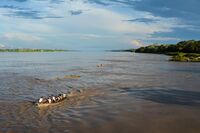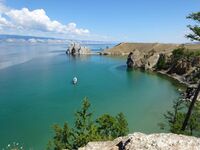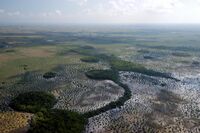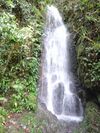Earth:Fresh water
Fresh water or freshwater is any naturally occurring liquid or frozen water containing low concentrations of dissolved salts and other total dissolved solids. Although the term specifically excludes seawater and brackish water, it does include non-salty mineral-rich waters such as chalybeate springs. Fresh water may encompass frozen and meltwater in ice sheets, ice caps, glaciers, snowfields and icebergs, natural precipitations such as rainfall, snowfall, hail/sleet and graupel, and surface runoffs that form inland bodies of water such as wetlands, ponds, lakes, rivers, streams, as well as groundwater contained in aquifers, subterranean rivers and lakes. Fresh water is the water resource that is of the most and immediate use to humans.
Water is critical to the survival of all living organisms. Many organisms can thrive on salt water, but the great majority of vascular plants and most insects, amphibians, reptiles, mammals and birds need fresh water to survive.
Fresh water is not always potable water, that is, water safe to drink by humans. Much of the earth's fresh water (on the surface and groundwater) is to a substantial degree unsuitable for human consumption without some treatment. Fresh water can easily become polluted by human activities or due to naturally occurring processes, such as erosion. Fresh water makes up less than 3% of the world's water resources, and just 1% of that is readily available. Just 3% of it is extracted for human consumption. Agriculture uses roughly two thirds of all fresh water extracted from the environment.[1][2][3]
Fresh water is a renewable and variable, but finite natural resource. Fresh water is replenished through the process of the natural water cycle, in which water from seas, lakes, forests, land, rivers and reservoirs evaporates, forms clouds, and returns inland as precipitation.[4] Locally, however, if more fresh water is consumed through human activities than is naturally restored, this may result in reduced fresh water availability (or water scarcity) from surface and underground sources and can cause serious damage to surrounding and associated environments. Water pollution also reduces the availability of fresh water.
Definitions
Numerical definition
Fresh water can be defined as water with less than 500 parts per million (ppm) of dissolved salts.[5]
Other sources give higher upper salinity limits for fresh water, e.g. 1,000 ppm[6] or 3,000 ppm.[7]
Systems
Fresh water habitats are classified as either lentic systems, which are the stillwaters including ponds, lakes, swamps and mires; lotic which are running-water systems; or groundwaters which flow in rocks and aquifers. There is, in addition, a zone which bridges between groundwater and lotic systems, which is the hyporheic zone, which underlies many larger rivers and can contain substantially more water than is seen in the open channel. It may also be in direct contact with the underlying underground water.
Sources
The original source of almost all fresh water is precipitation from the atmosphere, in the form of mist, rain and snow. Fresh water falling as mist, rain or snow contains materials dissolved from the atmosphere and material from the sea and land over which the rain bearing clouds have traveled. The precipitation leads eventually to the formation of water bodies that humans can use as sources of freshwater: ponds, lakes, rainfall, rivers, streams, and groundwater contained in underground aquifers.
In coastal areas fresh water may contain significant concentrations of salts derived from the sea if windy conditions have lifted drops of seawater into the rain-bearing clouds. This can give rise to elevated concentrations of sodium, chloride, magnesium and sulfate as well as many other compounds in smaller concentrations.
In desert areas, or areas with impoverished or dusty soils, rain-bearing winds can pick up sand and dust and this can be deposited elsewhere in precipitation and causing the freshwater flow to be measurably contaminated both by insoluble solids but also by the soluble components of those soils. Significant quantities of iron may be transported in this way including the well-documented transfer of iron-rich rainfall falling in Brazil derived from sand-storms in the Sahara in north Africa.[8]
In Africa, it was revealed that groundwater controls are complex and do not correspond directly to a single factor. Groundwater showed greater resilience to climate change than expected, and areas with an increasing threshold between 0.34 and 0.39 aridity index exhibited significant sensitivity to climate change. Land-use could affect infiltration and runoff processes. The years of most recharge coincided with the most precipitation anomalies, such as during El Niño and La Niña events. Three precipitation-recharge sensitivities were distinguished: in super arid areas with more than 0.67 aridity index, there was constant recharge with little variation with precipitation; in most sites (arid, semi-arid, humid), annual recharge increased as annual precipitation remained above a certain threshold; and in complex areas down to 0.1 aridity index (focused recharge), there was very inconsistent recharge (low precipitation but high recharge). Understanding these relationships can lead to the development of sustainable strategies for water collection. This understanding is particularly crucial in Africa, where water resources are often scarce and climate change poses significant challenges.[9]
Water distribution

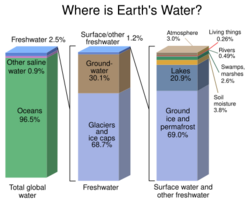
Saline water in oceans, seas and saline groundwater make up about 97% of all the water on Earth. Only 2.5–2.75% is fresh water, including 1.75–2% frozen in glaciers, ice and snow, 0.5–0.75% as fresh groundwater. The water table is the level below which all spaces are filled with water, while the area above this level, where spaces in the rock and soil contain both air and water, is known as the unsaturated zone. The water in this unsaturated zone is referred to as soil moisture. Below the water table, the entire region is known as the saturated zone, and the water in this zone is called groundwater.[11] despite being a hidden resource whose value is often overlooked, plays a crucial role as the primary source of water for various purposes including drinking, washing, farming, and manufacturing, and even when not directly used as a drinking water supply, it remains vital to protect due to its ability to carry contaminants and pollutants from the land into lakes and rivers, which constitute a significant percentage of other people's freshwater supply, and it's worth noting that groundwater is almost ubiquitous underground, residing in the spaces between particles of rock and soil or within crevices and cracks in rock, typically within 100 metres of the surface.[11] and soil moisture, and less than 0.01% of it as surface water in lakes, swamps and rivers.[12][13] Freshwater lakes contain about 87% of this fresh surface water, including 29% in the African Great Lakes, 22% in Lake Baikal in Russia, 21% in the North American Great Lakes, and 14% in other lakes. Swamps have most of the balance with only a small amount in rivers, most notably the Amazon River. The atmosphere contains 0.04% water.[14] In areas with no fresh water on the ground surface, fresh water derived from precipitation may, because of its lower density, overlie saline ground water in lenses or layers. Most of the world's fresh water is frozen in ice sheets. Many areas have very little fresh water, such as deserts.
Freshwater ecosystems
Water is a critical issue for the survival of all living organisms. Some can use salt water but many organisms including the great majority of higher plants and most mammals must have access to fresh water to live. Some terrestrial mammals, especially desert rodents, appear to survive without drinking, but they do generate water through the metabolism of cereal seeds, and they also have mechanisms to conserve water to the maximum degree.
Challenges
The increase in the world population and the increase in per capita water use puts increasing strains on the finite resources availability of clean fresh water. The response by freshwater ecosystems to a changing climate can be described in terms of three interrelated components: water quality, water quantity or volume, and water timing. A change in one often leads to shifts in the others as well.[15]
Limited resource

Water scarcity (closely related to water stress or water crisis) is the lack of fresh water resources to meet the standard water demand. There are two types of water scarcity namely physical and economic water scarcity.[17]:560 Physical water scarcity is where there is not enough water to meet all demands, including that needed for ecosystems to function. Arid areas for example Central Asia, West Asia, and North Africa often experience physical water scarcity.[11] Economic water scarcity on the other hand, is the result of lack of investment in infrastructure or technology to draw water from rivers, aquifers, or other water sources. It also results from weak human capacity to meet water demand.[17]:560 Much of Sub-Saharan Africa experiences economic water scarcity.[18]:11
There is enough freshwater available globally and averaged over the year to meet demand. As such, water scarcity is caused by a mismatch between when and where people need water, and when and where it is available.[19] The main drivers of the increase in global water demand are the increasing world population, rise in living conditions, changing diets (to more animal products),[20] and expansion of irrigated agriculture.[21][22] Climate change (including droughts or floods), deforestation, water pollution and wasteful use of water can also cause insufficient water supply.[23] Scarcity varies over time as a result of natural variability in hydrology. These variations in scarcity may also be a function of prevailing economic policy and planning approaches.Minimum streamflow
An important concern for hydrological ecosystems is securing minimum streamflow, especially preserving and restoring instream water allocations.[24] Fresh water is an important natural resource necessary for the survival of all ecosystems.
Water pollution
Society and culture
Human uses
Uses of water include agricultural, industrial, household, recreational and environmental activities.
Global goals for conservation
The Sustainable Development Goals are a collection of 17 interlinked global goals designed to be a "blueprint to achieve a better and more sustainable future for all".[25] Targets on fresh water conservation are included in SDG 6 (Clean water and sanitation) and SDG 15 (Life on land). For example, Target 6.4 is formulated as "By 2030, substantially increase water-use efficiency across all sectors and ensure sustainable withdrawals and supply of freshwater to address water scarcity and substantially reduce the number of people suffering from water scarcity."[25] Another target, Target 15.1, is: "By 2020, ensure the conservation, restoration and sustainable use of terrestrial and inland freshwater ecosystems and their services, in particular forests, wetlands, mountains and drylands, in line with obligations under international agreements."[25]
See also
- Earth:Limnology – Science of inland aquatic ecosystems
- Chemistry:Properties of water – Physical and chemical properties of pure water
Notes
- ↑ Each tiny cube[lower-roman 1] (such as the one representing biological water) corresponds to approximately 1400 cubic km of water, with a mass of approximately 1.4 trillion tonnes (235000 times that of the Great Pyramid of Giza or 8 times that of Lake Kariba, arguably the heaviest human-made object).[10]
- ↑ Only 3% of the Earth's water is fresh water. Most of it is in icecaps and glaciers (69%) and groundwater (30%), while all lakes, rivers and swamps combined only account for a small fraction (0.3%) of the Earth's total freshwater reserves.[citation needed]
Subnotes
- ↑ The entire block comprises 1 million tiny cubes.
References
- ↑ "Wastewater resource recovery can fix water insecurity and cut carbon emissions" (in en). https://www.eib.org/en/essays/wastewater-resource-recovery.
- ↑ "Competing for Clean Water Has Led to a Crisis" (in en). 26 January 2010. https://www.nationalgeographic.com/environment/article/freshwater-crisis.
- ↑ "Freshwater Resources | National Geographic Society". https://education.nationalgeographic.org/resource/freshwater-resources/.
- ↑ "The Fundamentals of the Water Cycle". https://www.usgs.gov/special-topic/water-science-school/science/fundamentals-water-cycle?qt-science_center_objects=0#qt-science_center_objects.
- ↑ "Groundwater Glossary". 27 March 2006. http://www.groundwater.org/gi/gwglossary.html#F.
- ↑ "Freshwater". Glossary of Meteorology. American Meteorological Society. June 2000. http://amsglossary.allenpress.com/glossary/search?p=1&query=freshwater.
- ↑ "Freshwater". Fishkeeping glossary. Practical Fishkeeping. http://www.practicalfishkeeping.co.uk/pfk/pages/glossary.php?entry_name=Freshwater.
- ↑ Rizzolo, Joana A.; Barbosa, Cybelli G. G.; Borillo, Guilherme C.; Godoi, Ana F. L.; Souza, Rodrigo A. F.; Andreoli, Rita V.; Manzi, Antônio O.; Sá, Marta O. et al. (22 February 2017). "Soluble iron nutrients in Saharan dust over the central Amazon rainforest". Atmospheric Chemistry and Physics 17 (4): 2673–2687. doi:10.5194/acp-17-2673-2017. Bibcode: 2017ACP....17.2673R. https://www.researchgate.net/publication/314247273.
- ↑ "Global climate change impacts on Sub-Sahara Africa: The case of Nigeria’s shorelines", The Impact of Climate Change on Sub-Sahara Africa (Peter Lang), http://dx.doi.org/10.3726/978-3-653-04584-0/15, retrieved 2023-12-19
- ↑ USGS – Earth's water distribution . Ga.water.usgs.gov (11 December 2012). Retrieved on 29 December 2012.
- ↑ 11.0 11.1 11.2 "Natural Quality of Water and Groundwater Contamination", Groundwater Contamination, Volume I (CRC Press): pp. 35–56, 2000-04-14, http://dx.doi.org/10.1201/9781482278934-9, retrieved 2023-12-19 Cite error: Invalid
<ref>tag; name ":0" defined multiple times with different content - ↑ Where is Earth's water? , United States Geological Survey.
- ↑ Physicalgeography.net . Physicalgeography.net. Retrieved on 29 December 2012.
- ↑ Gleick, Peter (1996). Stephen H. Schneider. ed. Encyclopedia of Climate and Weather. Oxford University Press. https://archive.org/details/encyclopediaofcl02schn.
- ↑ The World Bank, 2009 "Water and Climate Change: Understanding the Risks and Making Climate-Smart Investment Decisions". pp. 19–22. http://water.worldbank.org/water/publications/water-and-climate-change-understanding-risks-and-making-climate-smart-investment-decisi.
- ↑ Cite error: Invalid
<ref>tag; no text was provided for refs named:15 - ↑ 17.0 17.1 Caretta, M.A., A. Mukherji, M. Arfanuzzaman, R.A. Betts, A. Gelfan, Y. Hirabayashi, T.K. Lissner, J. Liu, E. Lopez Gunn, R. Morgan, S. Mwanga, and S. Supratid, 2022: Chapter 4: Water. In: Climate Change 2022: Impacts, Adaptation and Vulnerability. Contribution of Working Group II to the Sixth Assessment Report of the Intergovernmental Panel on Climate Change [H.-O. Pörtner, D.C. Roberts, M. Tignor, E.S. Poloczanska, K. Mintenbeck, A. Alegría, M. Craig, S. Langsdorf, S. Löschke, V. Möller, A. Okem, B. Rama (eds.)]. Cambridge University Press, Cambridge, UK and New York, NY, USA, pp. 551–712, doi:10.1017/9781009325844.006.
- ↑ IWMI (2007) Water for Food, Water for Life: A Comprehensive Assessment of Water Management in Agriculture. London: Earthscan, and Colombo: International Water Management Institute.
- ↑ Mekonnen, Mesfin M.; Hoekstra, Arjen Y. (2016). "Four billion people facing severe water scarcity" (in en). Science Water Stress Advances 2 (2): e1500323. doi:10.1126/sciadv.1500323. ISSN 2375-2548. PMID 26933676. Bibcode: 2016SciA....2E0323M.
- ↑ Liu, Junguo; Yang, Hong; Gosling, Simon N.; Kummu, Matti; Flörke, Martina; Pfister, Stephan; Hanasaki, Naota; Wada, Yoshihide et al. (2017). "Water scarcity assessments in the past, present, and future: Review on Water Scarcity Assessment" (in en). Earth's Future 5 (6): 545–559. doi:10.1002/2016EF000518. PMID 30377623.
- ↑ Vorosmarty, C. J. (2000-07-14). "Global Water Resources: Vulnerability from Climate Change and Population Growth". Science 289 (5477): 284–288. doi:10.1126/science.289.5477.284. PMID 10894773. Bibcode: 2000Sci...289..284V. https://www.science.org/doi/10.1126/science.289.5477.284.
- ↑ Ercin, A. Ertug; Hoekstra, Arjen Y. (2014). "Water footprint scenarios for 2050: A global analysis" (in en). Environment International 64: 71–82. doi:10.1016/j.envint.2013.11.019. PMID 24374780.
- ↑ "Water Scarcity. Threats". WWF. 2013. http://worldwildlife.org/threats/water-scarcity.
- ↑ Peter Gleick; Heather Cooley; David Katz (2006). The world's water, 2006–2007: the biennial report on freshwater resources. Island Press. pp. 29–31. ISBN 978-1-59726-106-7. https://books.google.com/books?id=Lttb1qPh4Z8C. Retrieved 12 September 2009.
- ↑ 25.0 25.1 25.2 United Nations (2017) Resolution adopted by the General Assembly on 6 July 2017, Work of the Statistical Commission pertaining to the 2030 Agenda for Sustainable Development (A/RES/71/313 )
External links
- The World Bank's work and publications on water resources
- U.S. Geological Survey
- Fresh Water National Geographic
 |
